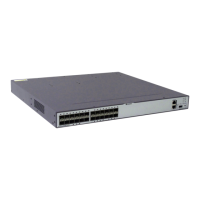6.15.1 Establishing the Configuration Task
Before configuring the IPv6 IS-IS route convergence speed, familiarize yourself with the
applicable environment, complete the pre-configuration tasks, and obtain the data required for
the configuration. This will help you complete the configuration task quickly and efficiently.
Applicable Environment
The procedure for implementing IS-IS is as follows:
l Establishment of neighboring relationships: establishes neighboring relationships by
exchanging Hello packets between two devices.
l LSP flooding: implements LSDB synchronization between devices in the same area.
l SPF calculation: uses the SPF algorithm to calculate IS-IS routes, and delivers the IS-IS
routes to the routing table.
To accelerate the IS-IS route convergence speed, configure the following parameters:
l Interval for detecting IS-IS neighboring device failures.
l Flooding parameters of CSNPs and LSPs.
l Interval for SPF calculation.
You can also configure convergence priorities for IPv6 IS-IS routes so that key routes can be
converged by preference when a network topology changes. This minimizes adverse impacts on
key services.
Pre-configuration Tasks
Before configuring the IPv6 IS-IS route convergence speed, complete the following tasks:
l Configuring the link layer protocol on interfaces.
l Configuring IP addresses for interfaces to ensure that neighboring nodes are reachable at
the network layer.
l Configuring Basic IPv6 IS-IS Functions.
Data Preparation
To configure the IPv6 IS-IS route convergence speed, you need the following data.
No.
Data
1 Interval at which Hello packets are sent and the holding time of neighboring
devices
2 Flooding time of CSNPs and LSPs
3 Interval for SPF calculation
4 Route convergence priority
S6700 Series Ethernet Switches
Configuration Guide - IP Routing 6 IS-IS Configuration
Issue 01 (2012-03-15) Huawei Proprietary and Confidential
Copyright © Huawei Technologies Co., Ltd.
305

